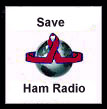 |
Space Weather Info
Posted 01 Nov 2003
Updated 05 May 2005
We are often concerned about the local atmospheric weather. Rain and wind have an immediate effect on our lives.
Daily, long and short range communications are affected by the Sun.
As Hams, we should understand the other weather that affects our hobby, Space Weather.
| Northern Hemisphere Auroral Activity |

|
| |
|
This plot shows the current extent and position of the auroral oval in the northern hemisphere, extrapolated from measurements taken during the most recent polar pass of the NOAA POES satellite.
The red arrow in the plot, that looks like a clock hand, points toward the noon meridian.
This presentation provides an estimate of the location, extent, and intensity of aurora on a global basis. For example, the presentation gives a guide to the possibility that the aurora is located near a given location in the northern hemisphere under the conditions that existed at the time of the most recent polar satellite pass.
|
| Solar Coronal Activity |

|
| |
|
These images show the outer Solar atmosphere, or corona, as viewed by the GOES 12 Solar X-ray Imager (SXI).
This region of the Sun has a temperature of one to several million degrees kelvin (Mega Kelvin MK) and is active on a time-scale of seconds to weeks.
Here the green image represents the ionized gas (plasma) of the corona at about 4.0 MK.
Bright areas, referred to as active regions, are associated with sunspots seen in white light images and may produce explosive events known as flares.
Dark regions are coronal holes where the fastest solar wind originates.
|
| Sunspot Cycle Predictions |

|
| |
|
Predicting the behavior of a sunspot cycle is fairly reliable once the cycle is well underway, about 3 years after the minimum in sunspot number occurs.
Prior to that time the predictions are less reliable but nonetheless equally as important.
Planning for satellite orbits and space missions often require knowledge of solar activity levels years in advance.
A number of techniques are used to predict the amplitude of a cycle during the time near and before sunspot minimum.
Relationships have been found between the size of the next cycle maximum and the length of the previous cycle, the level of activity at sunspot minimum, and the size of the previous cycle.
Among the most reliable techniques are those that use the measurements of changes in the Earth's magnetic field at, and before, sunspot minimum.
These changes in the Earth's magnetic field are known to be caused by solar storms but the precise connections between them and future solar activity levels is still uncertain.
|
|





